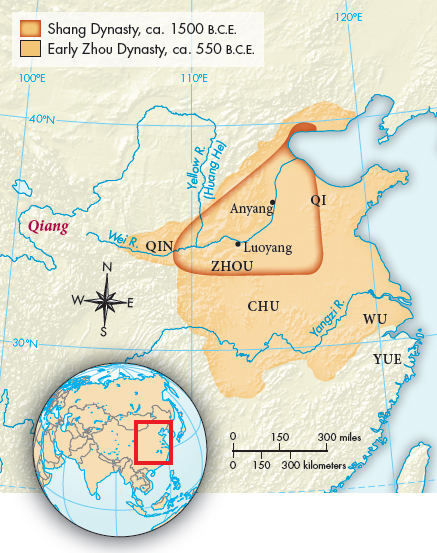A History of World Societies:
Printed Page 92
A History of World Societies Value
Edition: Printed Page 91
Shang Society

Shang civilization was not as densely urban as that of Mesopotamia, but Shang kings ruled from large settlements (Map 4.2). The best excavated is Anyang, from which the Shang kings ruled for more than two centuries. At the center of Anyang were large palaces, temples, and altars. These buildings were constructed on rammed-
Texts found in the Shang royal tombs at Anyang show that Shang kings were military chieftains. The king regularly sent out armies of three thousand to five thousand men on campaigns, and when not at war they would go on hunts lasting for months. They fought rebellious vassals and foreign tribes, but the situation constantly changed as vassals became enemies and enemies accepted offers of alliance. War booty was an important source of the king’s revenue, especially the war captives who could be made into slaves. Captives not needed as slaves might end up as sacrificial victims — or perhaps the demands of the gods and ancestors for sacrifices were a motive for going to war.
Bronze-

Shang power did not rest solely on military supremacy. The Shang king was also the high priest, the one best qualified to offer sacrifices to the royal ancestors and the high god Di. Royal ancestors were viewed as able to intervene with Di, send curses, produce dreams, assist the king in battle, and so on. The king divined his ancestors’ wishes by interpreting the cracks made in heated cattle bones or tortoise shells prepared for him by professional diviners.
The Shang royal family and aristocracy lived in large houses built on huge platforms of rammed earth similar to those used in the Neolithic period. Shang palaces were undoubtedly splendid but were constructed of perishable material like wood, and nothing of them remains today, giving China none of the ancient stone buildings and monuments so characteristic of the West. What has survived are the lavish underground tombs built for Shang kings and their consorts.
The one royal tomb not robbed before it was excavated was for Lady Hao, one of the many wives of the king Wu Ding (ca. 1200 B.C.E.). The tomb was filled with almost 500 bronze vessels and weapons, over 700 jade and ivory ornaments, and 16 people who would tend to Lady Hao in the afterlife. Human sacrifice did not occur only at funerals. Inscribed bones report sacrifices of war captives in the dozens and hundreds. Some of those buried with kings were not sacrificial victims but followers or servants. The bodies of people who voluntarily followed their ruler to the grave were generally buried with their own ornaments and grave goods such as weapons.
Shang society was marked by sharp status distinctions. The king and other noble families had family and clan names transmitted along patrilineal lines, from father to son. Kingship similarly passed along patrilineal lines, from elder to younger brother and from father to son, but never to or through sisters or daughters. The kings and the aristocrats owned slaves, many of whom had been captured in war. In the urban centers there were substantial numbers of craftsmen who worked in stone, bone, and bronze.
Shang farmers were obligated to work for their lords (making them essentially serfs). Their lives were not that different from the lives of their Neolithic ancestors, and they worked the fields with similar stone tools. They usually lived in small, compact villages surrounded by fields. Some new crops became common in Shang times, most notably wheat, which had spread from western Asia. Farmers probably also raised silkworms, from whose cocoons fine silk garments could be made for the ruling elite.